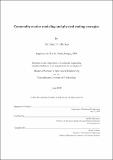Commodity market modeling and physical trading strategies
Author(s)
Ellefsen, Per Einar
DownloadFull printable version (2.173Mb)
Other Contributors
Massachusetts Institute of Technology. Dept. of Mechanical Engineering.
Advisor
Paul D. Sclavounos.
Terms of use
Metadata
Show full item recordAbstract
Investment and operational decisions involving commodities are taken based on the forward prices of these commodities. These prices are volatile, and a model of their evolution must correctly account for their volatility and correlation term structure. A two-factor model of the forward curve is proposed and calibrated to the crude oil, shipping, natural gas, and heating oil markets. The theoretical properties of this model are explored, with focus on its decomposition into independent factors affecting the level and slope of the forward curve. The two-factor model is then applied to two problems involving commodity prices. An approximate analytical expression for the prices of Asian options is derived and shown to explain the market prices of shipping options. The floating storage trade, which appeared in the oil market in late 2008, is presented as an optimal stopping problem. Using the two-factor model of the forward curve, the value of storing crude oil is derived and analyzed historically. The analytical framework for physical commodity trading that is developed allows for the calculation of expected profits, risks involved, and exposure to the major risk factors. This makes it possible for market participants to analyze such physical trades in advance, creates a decision rule for when to sell the cargo, and allows them to hedge their exposure to the forward curve correctly.
Description
Thesis (S.M.)--Massachusetts Institute of Technology, Dept. of Mechanical Engineering, 2010. Cataloged from student-submitted PDF version of thesis. Includes bibliographical references (p. 114-116).
Date issued
2010Department
Massachusetts Institute of Technology. Department of Mechanical EngineeringPublisher
Massachusetts Institute of Technology
Keywords
Mechanical Engineering.